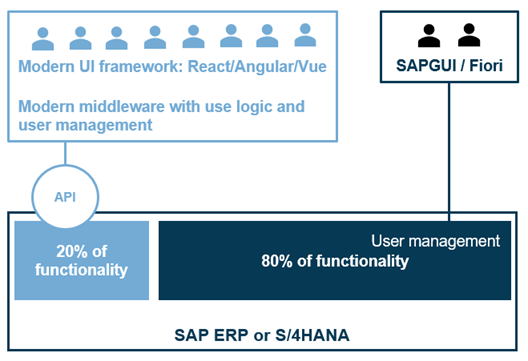In this blog, we go deeper into the technical architecture and explain how we have implemented headless SAP for our customers.
1. An introduction to headless SAP
The concept and benefits are described in our previous blog.

2. Headless SAP architecture – an example
We applied headless architecture to a tricky customer challenge that demanded an intuitive user interface plus lightning-fast response times. The business-critical process was already running on SAP, and only minimal changes to the existing SAP solution were allowed.
Below we explain our architecture on three levels:
- UI development and framework
- Front-end application
- SAP back end and connectivity
Our favourite platform for headless SAP development is Microsoft Azure, but similar architecture and concepts are available from all the major cloud platforms.

UI development and framework
The solution required a fast, reliable, and state-of-the-art front end. React was chosen as the front-end framework because of its excellent adaptability and proven reliability.
Front-end application
The solution’s core logic is built on top of Azure Function, a serverless offering that enables pay-per-use pricing and scaling from a few to millions of requests per hour – perfect for our solution, which will experience heavy loads during peak hours and low utilization outside of business hours. CosmosDB is a database solution that supports our core logic implementation by storing and staging data required by the application.
Azure AD is used for user authentication and authorization, allowing us to provide users with a familiar and secure login process and to isolate our front-end application from SAP back-end user management.
SAP back end and connectivity
The magic of our headless SAP architecture lies in how we integrate a modern UI framework and front-end application with an existing SAP back end.
We expose SAP ERP 6.0 business processes via a modern REST API on top of the Azure platform. All SAP development details, user management issues, and connectivity complexities are hidden behind this API. Reading and writing data to SAP is as easy as using any web API.

With SAP Gateway we converted the SAP data model to a standardized OData format without any changes to core business processes. The old ERP system became a modern web server with surprisingly little effort.
3. Developing headless SAP
Headless SAP architecture shows promise as a design principle. In addition, we have found several benefits during the development and operation phases compared to traditional SAP development:
- We were able to bring in developers without an SAP background.
- We achieved agile delivery with best-of-breed development and deployment tools.
- With little to no SAP custom development needed, it was possible to keep the core clean and stable.
Headless architecture allowed us to pinpoint bottlenecks and solve issues easily. The solution was so well contained, we were able to test parts of the application individually and determine the source of problems. In coupled architecture, this would not have been possible.
4. Smooth transition to S/4HANA
Our example was developed against SAP ERP 6.0. The transition to S/4HANA will be smooth both from a user and a technical perspective. Users can continue to use their front-end application normally after the S/4HANA transition, and only a few ABAPers need to migrate APIs from ERP to S/4HANA. S/4HANA might require minor changes to ABAP code due to the simplified data model in the HANA database.

Are you ready to delight your SAP users with a superior user experience and make your organizational journey to S/4HANA a smooth one? Here’s how:
- Make the decision to switch to headless SAP architecture.
- Define your headless architecture – i.e., the UI framework and front-end application platform We can help you with this step.
- Make your first pilot front-end application and UIs with our help.
Got interested? Connect with Kari and Jarkko on LinkedIn!
Join the SAP GO community
Accelerate your transformation journey by joining the community and we'll keep you updated.
Join now!Headless SAP
This Finnish speaking video shows you a practical example of the headless SAP architecture.
